Limiting Factors of Photosynthesis Assignment Help
NO NEED TO LOOK AROUND FURTHER AS EXPERTSMIND.COM IS HERE TO GUIDE YOU IN THE BEST POSSIBLE MANNER WITH ITS EXPLICT LIMITING FACTORS OF PHOTOSYNTHESIS ASSIGNMENT HELP SERVICE!!
Introduction
Photosynthesis is the physiological process through which green plants prepare their own food. Plants are termed as autotrophs. Sunlight is the source of their energy. It is captured in the green coloured pigments known as chlorophyll. Chlorophyll molecules are found in the cellular organelles called chloroplasts. Chloroplast are not exclusive to plants even some of the bacteria and algae have it. The raw materials required for the process of photosynthesis are Light, chlorophyll and carbon dioxide. Any factor or material, which is deficient or in limited supply then it, dictates the rate of the reaction of photosynthesis, is termed as limiting factor. Photosynthetic reactions are classified into light –independent and light-dependant reactions.
Factors influencing the rate of photosynthesis
Temperature
It is a positive regulator of the photosynthesis. Increase in the temperature increases the rate as it directly increases the energy of the molecules. Enzymes in the plant cells also work with higher speed until a certain amount of temperature. Beyond a threshold limit the enzymes also known as biological catalysts get degraded decreasing the level of photosynthesis.
Light
Intensity of light is measured in lux. A higher intensity of light increases the rate at which photosynthesis is carried out. The pigment molecules absorb the energy from the photons and transfer it to the electrons. The light energy is fixed into the form of chemical energy. Extreme light intensities often send the photosynthetic apparatus into overdrive and shut it down.
Carbon dioxide
The carbon available in this form is fixed into the complex carbohydrate form i.e., glucose and thereby starch. Increase in the levels of carbon dioxide always increases the level of photosynthesis and unlike other factors there is no knowledge on how higher levels of carbon dioxide can hamper the photosynthesis.
Chlorophyll
The green pigment molecules situated in the thylakoid membrane are specially designed structures in the chloroplasts to trap the sunlight. The centres involved in this process are called as photosystems. There are two photosystems II & I.
Water
This component contributes to the release of oxygen by splitting during photosynthesis, into the atmosphere unlike the believed carbon dioxide. When the water levels are low, the stomata (pores in the underside of the leaf) close reducing the availability of carbon dioxide. The guard cells surrounding stomata absorb water and swell up to open the stomata.
Limiting factor
For any reaction to proceed without interruption all the materials are required in adequate quantities. Lack of any reactant or deficiency of temperature, light, carbon dioxide , water, presence of any disease decides the level of photosynthesis.
Experiment
Objective
In this experiment, we are investigating the effect of a limiting factor viz. temperature on the rate of photosynthesis in an aquatic plant Hydrilla. A variable is a quantity whose values changes over time in an experiment. Constants are the quantities whose values are regulated and maintained same. In other words, temperature is the independent variable in the current study whereas rate of photosynthetic reaction serves as the dependant variable. Rate of reactions is often represented by the loss of the reactants or the production of the products i. e. rate at which either reactants are consumed, or products synthesised will be the dependent variable. Photosynthetic reaction can be summarised below
Carbon dioxide (CO2) + Water (H2O) à Glucose (C6H12O6) + oxygen(O2)
The reactants in photosynthesis in carbon dioxide and water that get converted to products water and oxygen. Therefore, rate of turnover any of the compounds can serve as dependent variable. In the current study the amount of oxygen produced in a given time will be used to determine rate of photosynthesis i.e. rate of oxygen release that serve as indicator of photosynthetic rate will be dependent variable Table 1.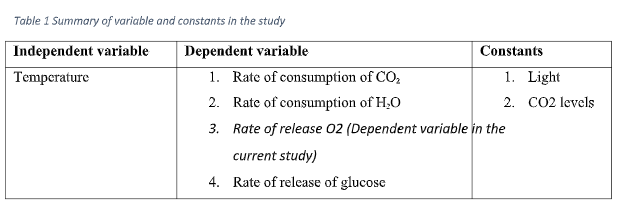
As the study is intended to assess the effect of temperature only, all other factors were kept constant. The experiment was done under artificial illumination. Carbon dioxide concentration available to plants was kept at constant by growing them in a dilute solution of Sodium bicarbonate. The rate of photosynthesis will be measured by determining the quantity of oxygen collected in the gas syringe.
Materials
1. Any perennial aquatic plant (eg; Hydrilla)
2. Conical Flask (250ml)
3. 5ml Syringe
4. Capillary tubing
5. Thermometer
6. Stand with clamps
7. Ruler
8. Stop watch
9. Lamp
10. NaHCO3 Solution (0.2M)
11. Electric heater with thermostat function
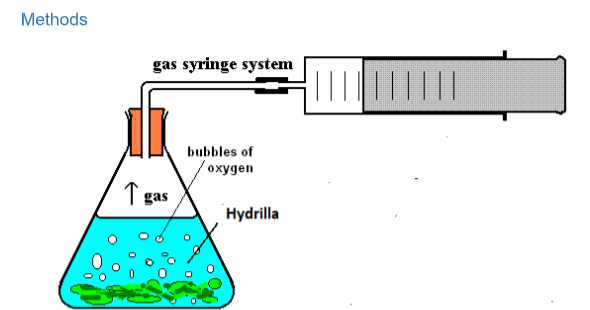
Figure 1 Diagrammatic representation of experimental setup
1. Cut the stem of a Hydrilla plant with uniform sized leaves.
2. Place the plant inside the conical flask and submerge it using sodium bicarbonate solution and place the flask on the heater
3. Close the mouth of the conical flask with one holed cork stop.
4. Pass one end of the capillary tube through the stopcock and connect the other end to the nozzle of the syringe mounted on a stand, Ref Figure 1.
5. Heat the conical flask to pre-set temperatures and measure the volume of oxygen collected in the syringe in 30 min. The temperatures used can be in the range of 25 to 45 °C in the increments of 2 °C.
6. Plot a graph with temperature in the X axis and volume of oxygen release in 30 min in the y-axis.
Results
The amount of oxygen released at different temperatures is tabulated as below Table 2,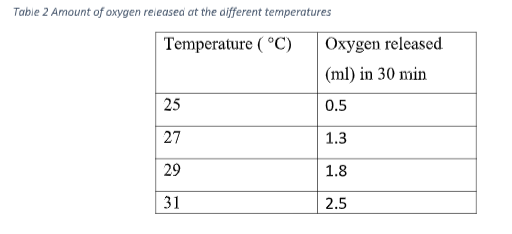
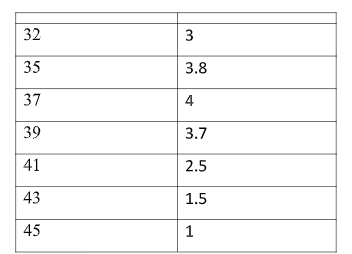
The amount oxygen released increased as the temperatures were raised. However, this increase was not indefinite. At temperature beyond 37 °C the rate of oxygen release started to decrease rapidly Figure 2.
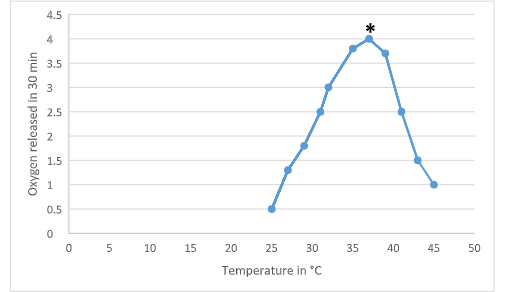
Fig 2 Graph showing change in photosynthetic rate in relation change in temperature.
Limitations
• Oxygen gas might leak through the tubing while collecting it.
• Temperature sometimes vary during the course of the experiment.
• Each leaf of the plant might not have the same surface area during different set up of the experiment.
Inference
Increase in the temperature steadily increased the rate of photosynthesis and reached a peak value. Beyond the highest value, the rate diminished over time.
Conclusion
Photosynthesis is a chemical process, which utilizes the light form of energy to synthesize the complex chemical compounds. Light –dependent reactions involving the capturing of the sunlight are not affected by the temperature. The captured energy is then transferred into the compounds through the action of the enzymes. These enzymes are chemically protein molecules which are stable at optimum temperatures. Any increase in temperature leads to the increased kinetic energy and lowered activation energy and an increased enzyme activity. Extreme temperatures break the bonds in these molecules and degrade them irreparably. This is represented by the decreased oxygen production in the set up with a higher temperature.
GET YOUR ASSIGNMENT SOLUTIONS IN THE BLINK OF AN EYE, WITHOUT ANY HASSEL, IN THE PRESCRIBED TIME FRAME!!